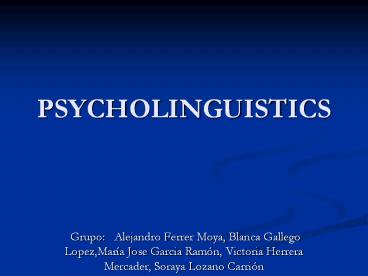PSYCHOLINGUISTICS PowerPoint PPT Presentation
Title: PSYCHOLINGUISTICS
1
PSYCHOLINGUISTICS
- Grupo Alejandro Ferrer Moya, Blanca Gallego
Lopez,María Jose Garcia Ramón, Victoria Herrera
Mercader, Soraya Lozano Carrión
2
INDEX
- INTRODUCTION
- LANGUAGE ACQUISITION
- DEFINITION
- THEORIES
- PRACTICAL APPLICATIONS
- CHILD LANGUAGE DEVELOPMENT
- BILINGUALISM
- CONCLUSION
3
INTRODUCTION
- WHAT IS PSYCHOLINGUISTICS?
- "Psycholinguistics is the study of the cognitive
process that supports the acquisition and use of
language" Schmitt, N. - "Psycholinguistics is the study of how the mind
equips human beings to handle language" Simpson,
J
4
INTRODUCTION
- HISTORY
- Over the centuries...
- Language discussions of language acquisition
and of the origins of language. - Nineteenth century...
- Parallel interest in the psichology of adult
language development
5
INTRODUCTION
- Twentieth century...
- First half Behaviorism
- Second half Miller and Chomsky
6
INTRODUCTION
- Second century....
- First half Behavourism.
- Second half Miller and Chomsky.
- Today...
- Psycholinguistics is a multidisciplinary
field, drawing upon cognitive psychology,
theoretical linguistics.....
7
LANGUAGE ACQUISITION
- DEFINITION
- THEORIES
8
NATIVIST THEORY
- CHOMSKY'S ASSERTIONS language is an innately
acquired faculty - Arguments
- The sort period of time while a child achieves
grammatical competence. - The lack of correction or explicit teaching by
adults.
9
NATIVIST THEORY
- The poverty of the stimuls available to the
child. - All normally developing children acquie full
competence
10
NATIVIST THEORY
- UNIVERSAL GRAMMAR (UG)
- Components
- Principles they enable the infant to
recognise features that are common to most or all
of the world's languages. - Parameters they can be set to accord with the
language to wich the child is exposed
11
NATIVIST THEORY
- CRITICAL PERIOD THEORY
- The two emispheres might be "plastic" at birth
- The left hemisphere gradually becoming the
dominant one for language during the five first
years of life - It was not corroborated by recent studies and
commentators extended the cut-off point to
adolescence
12
ALTERNATIVE THEORIES
- Many alternatives to the nativist view emphasize
the role of the LINGUISTIC ENVIRONMENT to which
the child is exposed - Jean Piaget (Piatelli-Palmerini 1980)
- Language acquisition is driven by COGNITIVE
DEVELOPMENT as the child succeeds in making sense
of the world around it.
13
ALTERNATIVE THEORIES
- Other cognitive accounts Human mind structure
permits to trace patterns in real-world
phenomena, including speech, without special
language-related device. - Deacon (1997) It is possible that language took
advantage of cognitive operations that served
other purposes and that the brain then gradually
evolved to accommodate it.
14
ALTERNATIVE THEORIES
- Simulations of language acquisition based on
computer modeling A so-called return to
empiricism (even behaviorism) A connectionist
computer program capable of acquiring accurate
past tense links. Even though - No abstract rule
- Based upon generalization across examples and
exceptions. - However, whether this kind of program achieves
its goal or not is open to challenge.
15
PRACTICAL APPLICATIONS
- CHILD LANGUAGE DEVELOPMENT
- SECOND LANGUAGE ACQUISITION AND BILINGUALISM
16
Child language development
- Is language innate?
- Many studies have investigated syntax, morhpology
lexis an phonology. - syntax verbs used and its valencies.
- Morphology whether inflecions are acuired by a
child in a fixed order. - lexis the way in which infants succeed in
associating meanings with words.
17
Child language development
- Phonology child face important challenges of
establishing articulatory setting and of
co-ordinating the movement of the articulators
from one to another.
18
L2 AND BILINGUALISM
- Example
- English-spanish bilinguals judge wheter letter
strings are real words in their L2. These words
are false friend. - Spainsh the word red means net
- English the word red refers to a color.
19
CONCLUSION
20
REFERENCES
- SIMPSON, J. (ed). 2011. The Routledge Handbook of
Applied Linguistics. Routledge. - SCHMITT, N. (ed). 2010. An introduction to
applied linguistics. Hodder Education.

